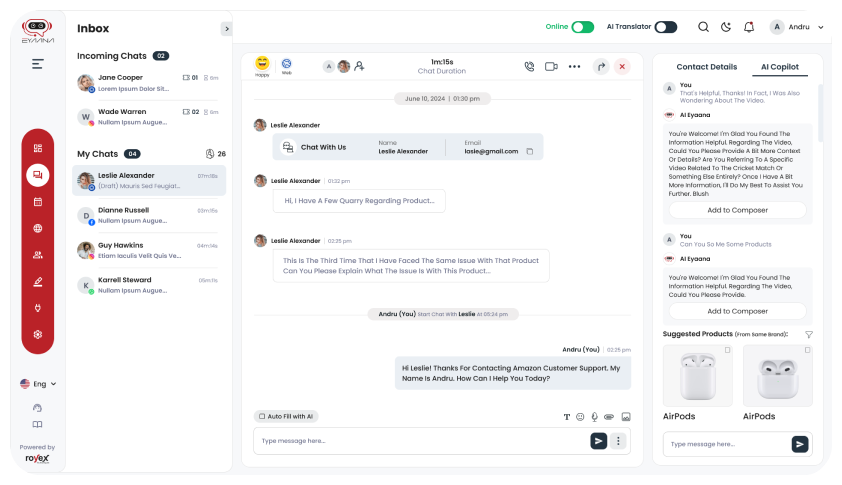Enquiry
Blog Details
How Customer Service is Evolving: Key Trends Everyone Should Know
Let’s talk about something every business owner knows deep down: great customer service is the heart of any successful company. But staying ahead in today’s fast-changing world isn’t easy. Customers expect quicker responses, smarter solutions, and experiences that feel personal. Thankfully, technology—especially AI—is here to help businesses meet those growing expectations.
In this article, we’ll explore the top trends shaping customer service in 2024 and beyond. We’ll dive into how AI is changing the way companies solve problems, why personalization is more important than ever, and how some timeless strategies are still going strong.
1. The Rise of AI Assistants
![the-rise-of-ai-assistants-min[1].jpg](/media/r1apsqsf/the-rise-of-ai-assistants-min-1.jpg)
AI assistants, like chatbots, are revolutionizing how businesses assist customers. These tools are available 24/7, providing instant responses to common questions like tracking an order or resetting a password. This means customers get quick help anytime they need it. AI doesn’t replace human agents, though. It handles repetitive tasks, leaving the more complex and personal issues for human staff. Over time, AI improves by learning from each interaction, offering more accurate answers. This partnership between AI and human agents boosts efficiency and customer satisfaction.
While AI can handle basic queries, it can’t replace the empathy and problem-solving abilities of human agents. For more complicated situations, such as emotional issues or customized solutions, a human touch is essential. AI and human support teams working together create a balance, making customer service faster and more effective for everyone.
2. Keeping It Personal
Even with all the advancements in technology, people still value genuine human connection. Customers want to feel heard and understood, especially when dealing with frustrating issues. Empathy, clear communication, and a willingness to find solutions go a long way in building trust. Human agents who can relate to customers on a personal level remain irreplaceable in creating memorable service experiences.
On the other hand, technology can help human agents by giving them the right information quickly. AI can collect data and provide context, allowing the human agents to focus on solving problems and building relationships. A blend of personal service and technological support helps businesses provide a truly meaningful experience that keeps customers coming back.
3. Omnichannel Support
Today’s customers reach out for support in many different ways, such as through email, social media, live chat, or phone calls. Omnichannel support ensures that customers can start a conversation on one platform and seamlessly continue it on another without losing any context. For example, you might ask a question on Facebook and get follow-up help through email. This makes it easier for customers to reach businesses in the way that’s most convenient for them.
Offering support across multiple platforms also builds brand trust. When a company provides consistent and smooth service, regardless of the channel, customers feel confident and valued. This omnichannel approach shows that businesses are flexible, organized, and willing to meet their customers’ needs on their terms.
4. Personalized Experiences
![personalized-experiences-min[1].jpg](/media/krcjfb3y/personalized-experiences-min-1.jpg)
Gone are the days when businesses treated every customer the same. Personalization is more than just calling a customer by name. Today, personalization is key to standing out. It’s about understanding their preferences and providing tailored solutions. Businesses now use customer data to recommend products or services that match past purchases or browsing history. For example, if a customer frequently buys a specific type of product, the company might offer discounts or suggest similar items they might like.
Personalized service doesn’t just feel good—it builds loyalty. When customers feel valued as individuals, they’re more likely to stick around. When they feel like a business understands their needs and is catering to them, they’re more likely to stay loyal. Personalization doesn’t always require complex technology—it’s about making each interaction meaningful and relevant, showing customers they matter.
5. Self-Service Options
More customers are choosing to solve problems on their own, especially for simple issues. Businesses are responding by offering self-service tools, such as FAQs, video tutorials, and detailed help guides. These resources allow customers to quickly find answers without having to wait for an agent. It gives them the control to fix problems when it’s convenient for them, improving overall satisfaction.
However, while self-service tools are great, they shouldn’t replace human support entirely. Sometimes customers encounter issues that they can’t solve on their own. In those cases, businesses must ensure that live help is available. Offering a balance of self-service tools and accessible customer support provides customers with the best of both worlds.
6. Proactive Support
Smart companies don’t wait for customers to report issues—they solve problems before they arise. Proactive support is about solving problems before customers even notice them. For example, a company might alert customers about a potential issue, like a scheduled service outage, and offer solutions before the customer experiences any disruption. This anticipatory approach builds trust because it shows customers that the business is thinking ahead and caring for their needs.
Proactive support reduces frustration and makes customers feel valued. By addressing problems early, businesses can improve customer satisfaction and prevent issues from escalating. This approach isn’t just about fixing things—it’s about creating a smooth experience for the customer, showing that the company is always looking out for them.
7. Emphasis on Feedback
![emphasis-on-feedback-min[1].jpg](/media/dcyb1wwq/emphasis-on-feedback-min-1.jpg)
Customer feedback is one of the most valuable tools for improving service. Whether through surveys, reviews, or direct feedback, it gives businesses insights into what’s working and what’s not. By actively listening to customers, companies can make informed decisions and adjust their services to better meet expectations.
But collecting feedback is only the first step. Acting on that feedback is crucial. When customers see that their opinions are valued and that businesses are making improvements based on their suggestions, it builds stronger loyalty. Companies that prioritize feedback are continuously growing and evolving alongside their customers’ needs.
8. Remote and Hybrid Support Teams
The rise of remote work has also impacted customer service teams. Many companies now employ support agents from different parts of the world, offering 24/7 support and access to a diverse talent pool. This allows businesses to provide help at all times, no matter where their customers are located.
Hybrid teams, where some agents work remotely while others work in-office, are becoming popular as well. This gives companies flexibility while ensuring collaboration and strong communication. Whether agents are working from home or an office, they can still provide excellent support, ensuring customers get the help they need, no matter the time or place.
Real-Life Use Cases of AI in Customer Service
AI is already transforming the customer service landscape, with companies across various industries utilizing AI to enhance customer experiences, streamline operations, and drive efficiency. Here are some real-life examples of how AI is being implemented in customer service:
1. Sephora’s Virtual Artist
Sephora, a global cosmetics retailer, uses AI through its Virtual Artist feature on their mobile app. This AI tool allows customers to try on makeup virtually by analyzing their facial features and skin tone. It uses augmented reality (AR) and AI to recommend products that match the user’s preferences, offering a personalized shopping experience without having to visit the store.
2. Lemonade Insurance’s AI Claims Processing
Lemonade, a tech-driven insurance company, leverages AI to automate claims processing. Customers can file claims through the app, and AI processes the information almost instantly. The AI system reviews the claim, compares it against previous cases, and approves or denies the request in a matter of minutes. This drastically reduces the time it takes for customers to receive payouts compared to traditional insurance companies.
3. H&M’s Virtual Assistant for Online Shopping
H&M, the global fashion retailer, uses an AI-powered virtual assistant called Ada to help customers find the right products on their website. Ada helps customers by answering product-related questions, guiding them to specific items based on their preferences, and providing size and style recommendations. The assistant can also assist with order tracking and returns.
4. Uber’s AI for Ride Matching and Customer Support
Uber uses AI in several ways to improve the customer experience. One of the primary uses is for ride matching, where AI predicts the nearest available driver based on location, traffic patterns, and rider preferences. Additionally, Uber uses AI-powered chatbots in its app to quickly resolve issues like payment problems, trip issues, and even customer feedback through a simple automated interface.
5. Bank of America’s Erica Virtual Assistant
Bank of America offers a virtual assistant named Erica, powered by AI, that helps customers with various banking tasks. Erica can assist with checking account balances, making payments, transferring funds, and providing financial advice. The virtual assistant uses machine learning to improve responses over time and adapt to the customer’s unique needs.
Final Thoughts
Customer service is constantly evolving, but its core remains the same: solving problems and building trust. By embracing these trends—balancing technology with a human touch, listening to feedback, and staying flexible—businesses can create experiences that truly stand out. Those that adapt and keep the customer at the heart of everything they do will not only survive but thrive in the years to come.
Why Eyaana is the Best Choice for AI Chatbot?
![why-eyaana-is-the-best-choice-min[1].jpg](/media/iz0dvyta/why-eyaana-is-the-best-choice-min-1.jpg)
If you’re looking for a powerful yet user-friendly AI chatbot solution, Eyaana, customer service ai is worth considering. With Eyaana, businesses can seamlessly turn website traffic into live, engaging conversations, making it easier to convert leads into customers.
Eyaana is designed to be an AI-first customer support and sales solution, meaning it comes with powerful automation features, yet it’s easy to use even for non-technical teams. Its inbuilt CRM and helpdesk make customer management simple, while its AI-driven chat capabilities provide a smart, personalized experience for users.
Inbuilt CRM and Helpdesk: Eyaana comes with a built-in CRM and helpdesk, allowing businesses to manage customer data and support interactions in one place.
Flexible Pricing: Choose from Eyaana’s Lite and Pro packages starting from $99/month, with flexible, commitment-free tiers tailored to suit businesses of all sizes.
Multilingual Support: Engage a diverse audience with language options like Arabic, English, Hindi, and Urdu.
AI-First Design: Eyaana’s chatbot learns over time, enhancing customer interactions and turning site visits into conversations.
Scalability: Eyaana adapts to business growth, handling higher customer interactions with ease.
24/7 Support & Analytics: Real-time data and round-the-clock support help improve customer experiences.
To explore how AI can enhance your business operations, sign up for free and get started with Eyaana today.
Do you need help?
We will provide detailed information about our services, types of work, and top projects. We will calculate the cost and prepare a commercial proposal.



































































































































